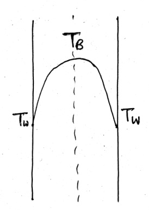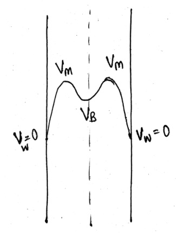This set of Heat Transfer Operations Multiple Choice Questions & Answers (MCQs) focuses on “Packed Beds – Mechanism of Heat Transfer”.
1. Packed bed reactors are ________ heat exchangers.
a) Indirect Contact
b) Direct Contact
c) Tubular
d) Plate-type
View Answer
Explanation: Packed bed HE are usually direct contact HE where the liquid and gas phase come directly in contact through the bed to transfer heat. Whereas the heat transfer in packed bed reactors is indirect contact type.
2. Which one of the following is not a use of packed bed?
a) Regenerators
b) Stripping
c) Mixing
d) Solid matrix heat exchangers
View Answer
Explanation: Packed beds are used in applications such as separators, absorbers, stripping, reactors absorption, regenerators, thermal insulations, grain storage, and solid matrix heat exchangers.
3. Why is heating or cooling required in packed beds if we don’t use it as a heat exchanger?
a) To Cool Exothermic reactions
b) To cool water by using ice as pellets
c) To cool petroleum by using ice as pellets
d) To heat exothermic reactions
View Answer
Explanation: One of the important use of packed beds is to heat endothermic reactions and also cool exothermic reactions by using it in a shell and tube arrangement.
4. It has been found that wall-cooled operations on packed beds show more effective heat transfer rate than wall-heated operations.
a) True
b) False
View Answer
Explanation: Yes, it has been experimentally proved that wall-cooled operations on packed beds are more effective than wall-heated operations because of minute heat loss in wall-heated operations.
5. Wall heated packed beds and wall cooled both have more or less the same correlations.
a) True
b) False
View Answer
Explanation: Earlier when the number of experiments conducted was less, the correlations were regarded to be same for the two operations, but later it was found that wall-cooled operations on packed beds show more effective heat transfer rate than wall-heated operations, hence the correlations were changed.
6. Why are Packed bed Heat Exchangers Direct contact type heat exchangers?
a) Because they create heavy mixing
b) Uses two fluids to transfer heat by dissolving into each other
c) Gas liquid system where they are brought to direct contact
d) Gas-Gas system where they are brought to direct contact
View Answer
Explanation: Packed bed Heat Exchangers are called Direct contact type heat exchangers because they usually bring two immiscible fluids to direct contact to exchange heat, in packed beds the most common use is that of Gas-Liquid systems.
7. Which of the following is not a valid operation of packed bed reactors?
a) Shell and Tube Setup
b) Indirect contact setup
c) Feedwater heater
d) Direct Contact setup
View Answer
Explanation: Packed bed reactors are not used as Feedwater heaters, but are definitely used as a Shell and tube setup to cool and heat exothermic or endothermic reactions respectively.
8. For an Endothermic Reaction, which of the following operation is best suited to support the reaction?
a) Shell and tube with hot fluid in shell and packed bed in tube
b) Shell and tube with cold fluid in shell and packed bed in tube
c) Shell and tube with hot fluid in tube and packed bed in shell
d) Shell and tube with cold fluid in tube and packed bed in shell
View Answer
Explanation: The best suited arrangement is a shell and tube setup with hot fluid in shell and packed bed in tube because endothermic reactions are supported in hot environment.
9. For an Exothermic Reaction, which of the following operation is best suited to support the reaction?
a) Shell and tube with hot fluid in shell and packed bed in tube
b) Shell and tube with cold fluid in shell and packed bed in tube
c) Shell and tube with hot fluid in tube and packed bed in shell
d) Shell and tube with cold fluid in tube and packed bed in shell
View Answer
Explanation: The best suited arrangement is a shell and tube setup with cold fluid in shell and packed bed in tube because endothermic reactions are supported in cold environment to absorb the heat released during the reaction.
10. As an Indirect contact HE, Packed beds have _______ fluid flow.
a) Continuous
b) Constant
c) Intermittent
d) Reversing
View Answer
Explanation: As an indirect contact HE, packed bed follow intermittent pattern of fluid flow, such as 1st send the hot fluid to heat the bed, to get itself cooled and then the cold fluid is sent to get heated up.
11. Packed Beds are one of the most common heat exchangers because of its very ______
a) High bed side heat transfer coefficient
b) High wall side heat transfer coefficient
c) High conductivity
d) Low heat transfer rate
View Answer
Explanation: Packed beds have high bed side heat transfer coefficient which facilitates profitable heat transfer, hence this is the reason why they are so commonly used.
12. In a Packed Bed Shell and Tube HE, the pellets are usually kept _______
a) At Tube Side
b) At Shell side
c) At any side as required
d) At floor of the shell
View Answer
Explanation: In a packed bed setup using a shell and tube heat exchanger, the pellets are usually kept in the tubes where mostly heat generating reactions take place and cold fluids are kept at the shell side to cool the reaction.
13. The Temperature profile in a packed bed reactor surrounded by a cooling liquid is__________
a) Fully parabolic
b) Parabolic near the walls
c) Flat at the centre
d) Concave downward near the walls and upward at the centre
View Answer
Explanation: The temperature profile of a packed bed with cooling liquid surrounding is represented as

Here the pattern is fully parabolic.
14. The Velocity profile in a packed bed reactor is__________
a) Fully parabolic
b) Parabolic near the walls
c) Flat at the centre
d) Concave downward near the walls and upward at the centre
View Answer
Explanation: The velocity profile of a packed bed with cooling liquid surrounding is represented as

Here the pattern is parabolic near the walls.
15. The pressure drop in a packed bed is _______ for a given length.
a) Constant
b) Exponentially Increasing
c) Parabolically Increasing
d) Linearly Increasing
View Answer
Explanation: The Pressure drop with the Bed length is Linear Function and is usually represented as Pressure drop per unit length of the packed bed.
Sanfoundry Global Education & Learning Series – Heat Transfer Operations.
To practice all areas of Heat Transfer Operations, here is complete set of 1000+ Multiple Choice Questions and Answers.
If you find a mistake in question / option / answer, kindly take a screenshot and email to [email protected]
- Check Chemical Engineering Books
- Practice Chemical Engineering MCQs
- Check Heat Transfer Operations Books
- Apply for Chemical Engineering Internship
